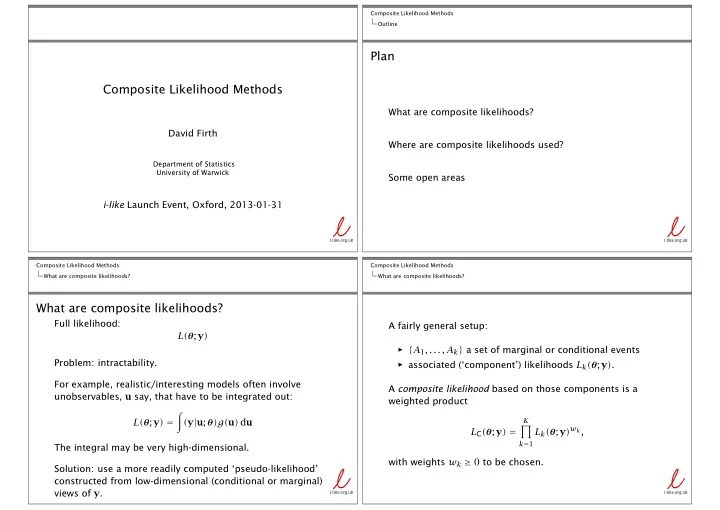

Composite Likelihood Methods Outline Plan Composite Likelihood Methods What are composite likelihoods? David Firth Where are composite likelihoods used? Department of Statistics University of Warwick Some open areas i-like Launch Event, Oxford, 2013-01-31 Composite Likelihood Methods Composite Likelihood Methods What are composite likelihoods? What are composite likelihoods? What are composite likelihoods? Full likelihood: A fairly general setup: L( θ ; y ) ◮ { A 1 , . . . , A k } a set of marginal or conditional events Problem: intractability. ◮ associated (‘component’) likelihoods L k ( θ ; y ) . For example, realistic/interesting models often involve A composite likelihood based on those components is a unobservables, u say, that have to be integrated out: weighted product � L( θ ; y ) = ( y | u ; θ )g( u ) d u K � L k ( θ ; y ) w k , L C ( θ ; y ) = k = 1 The integral may be very high-dimensional. with weights w k ≥ 0 to be chosen. Solution: use a more readily computed ‘pseudo-likelihood’ constructed from low-dimensional (conditional or marginal) views of y .
Composite Likelihood Methods Composite Likelihood Methods What are composite likelihoods? What are composite likelihoods? Conditional and marginal components Conditional and marginal components Marginal CL: Simplest example is the independence Conditional and marginal components pseudo-likelihood: m Conditional CL: e.g., Besag (1974) on approximate inference � L ind ( θ ; y ) = f(y r ; θ ) for spatial processes, r = 1 m (or onewise likelihood ). This neglects dependence structures; � L C ( θ ; y ) = f(y r |{ y s : y s is neighbour of y r } ; θ ). still sometimes useful, but can be inefficient. r = 1 One step further is a pairwise marginal composite likelihood, Other examples in analysis of time series, longitudinal e.g., based on marginal density of all pairs, studies, gene expression data, etc; e.g., pooling of full m − 1 m conditional densities, � � L pair ( θ ; y ) = f(y r , y s ; θ ). m r = 1 s = r + 1 � L C ( θ ; y ) = f(y r | y ( − r) ; θ ). This typically is informative about dependence parameters. r = 1 Possibly combine onewise and pairwise likelihoods for increased efficiency (Cox and Reid, 2004). Composite Likelihood Methods Composite Likelihood Methods What are composite likelihoods? What are composite likelihoods? Efficiency? Efficiency? Pseudo-likelihood, not likelihood. Fisher information not the right measure. Key matrices that generalize the Fisher information are the sensitivity −∇ 2 log L C ( θ ; Y ) � � H( θ ) = E and variability � � J( θ ) = var ∇ log L C ( θ ; Y ) . These combine to give the Godambe (‘sandwich’) information matrix, � J( θ ) − 1 � G( θ ) = H( θ ) H( θ ).
Composite Likelihood Methods Composite Likelihood Methods What are composite likelihoods? Where are composite likelihoods used? Efficiency? Where are composite likelihoods used? Lots of application areas already; and still growing rapidly. ◮ An estimate of G − 1 provides approximate standard errors of maximum composite likelihood estimators. Some ‘classic’ application areas are ◮ Variability matrix J is often difficult to estimate (the ◮ genetics (e.g., 2011 review paper by Larribe and most extreme cases being analyses of single time-series, Fearnhead) or single spatial arrays, where there is no replication to ◮ geostatistics (starting with Hjort and Omre, 1994) help with this). ◮ spatial extremes (recent work of A C Davison and ◮ Efficiency calculations compare G( θ ) with the others) full-likelihood Fisher information matrix. ◮ models with correlated random effects (spatial models; ◮ Aim to choose a composite likelihood that makes G( θ ) time series; multivariate/longitudinal data; network as ‘large’ as possible (subject to computational dependence models; etc.) tractability). ◮ financial econometrics and various others. (See VRF2011 for some more) Composite Likelihood Methods Composite Likelihood Methods Where are composite likelihoods used? Where are composite likelihoods used? An indication from 2013 so far: 6 citations of VRF2011
Composite Likelihood Methods Composite Likelihood Methods Where are composite likelihoods used? Where are composite likelihoods used? Composite Likelihood Methods Composite Likelihood Methods Where are composite likelihoods used? Where are composite likelihoods used?
Composite Likelihood Methods Composite Likelihood Methods Where are composite likelihoods used? Where are composite likelihoods used? Composite Likelihood Methods Composite Likelihood Methods Some open areas Some open areas Some open areas Some open areas There are lots! To mention just a few general ones: ◮ choice of components ◮ choice of ‘weights’ ◮ robustness? (e.g., Helen Jordan talk at Banff 2012) ◮ reliable estimation of variability matrix J( θ ) ◮ Bayesian use of L C ? (Pauli+ 2011; Ribatet+ 2012) ◮ interplay with other approaches (ABC, simulated Workshops at Warwick CRiSM (2008) and Banff International likelihoods, . . . ) Research Station (2012). Report on 2012 workshop (and webcasts of some of the talks) available online from etc., etc. www.birs.ca
Recommend
More recommend